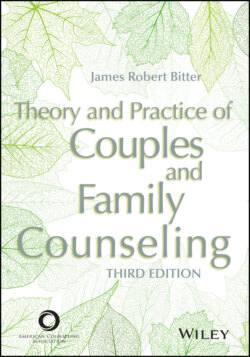Читать книгу Theory and Practice of Couples and Family Counseling - James Robert Bitter - Страница 15
CHAPTER 1
Introduction and Overview
ОглавлениеFifty years ago, family practice promised greater effectiveness than had been achieved with either individual or group counseling. Because these relational approaches sought to change the very systems in which individuals actually lived, many professionals hoped that the changes enacted would endure and that both individual and system relapse would disappear. Although these hopes have not been fully realized, family practice has had enormous success, and it is now a fully integrated part of most treatment programs.
Couples and family practice is fundamentally different from individual counseling. Although both couples and family systems share some similarities with groups, their intimacy and intensity make them a treatment unit unlike any other. Perhaps the hardest task for those trained to work with individuals is learning assessment and interventions with couples and families from multiple systemic perspectives. I will say more about this later. In the meantime, this book provides you with an invitation to experience the thinking of the pioneers and leaders who have shaped systemic approaches in the field of couples and family practice.
This book surveys 13 approaches to family counseling and practice, highlighting key concepts, therapy goals, techniques, process, and application. Two additional chapters that were part of an earlier edition of this book have been updated and are available on my website (www.jamesrobertbitter.com). These chapters are on symbolic-experiential family therapy (Carl Whitaker’s model) and effective approaches to parenting. I hope you will read this book with the goal of learning the breadth and depth of each counseling orientation. The models presented here sometimes have a great deal of similarity and sometimes are quite different and even contradict one another. Consider not only the ideas and interventions of each model but also the worldview espoused by both the founders of the theory and the practitioners who currently contribute to its development.
Each of these models will, most likely, have some relevance to your own family of origin. The family of origin is often a good place to start the personal exploration that is so essential to couples and family practice. It is almost axiomatic these days that family practitioners-in-training must consider the impact that their families of origin have had on their personal development (see McGoldrick, 2011a). If we do not make this journey into our own histories, we are in danger of trying to work out our personal family issues with every new family we encounter.
Over time, various ideas and models will start to appeal to you: They will fit with your values and beliefs and, in some cases, they will even enhance or broaden your worldview. You will start to create a foundation for your work, and you will find that parts of different models will integrate into that foundation. This is not a process that happens quickly. It will certainly not happen at the end of a course or two on the theories and practices of marriage and family counseling. This is a lifelong journey.
You might start by asking yourself the following questions:
What beliefs do these theorists and practitioners have about families in general?
Do I hold these same beliefs, ideas, or values, or do other values and positions seem more important to me?
If I were bringing my family of origin and/or my current family members to counseling with me, would I want to go to a family practitioner, counselor, or therapist using this approach? Why or why not? What would my expectations be? What goals would I have for the work I was contemplating in counseling?
What kind of relationship would I want to have with the family practitioner? What would contribute to my trust, comfort, willingness to work, determination to change, and feeling of accomplishment at the end?
There are useful parts to every theory and model we will consider in this book. None of the approaches considered here holds a claim to absolute truth, however, or even to the right way to do family practice. Each theory is built on a perspective and provides a different kind of lens through which families may be viewed and understood. And each of these perspectives inevitably has continually developing implications for family practice.
Finding a model or models that work for you is an important first step as a professional. Such a discovery provides a framework for working with the multitude of diverse families you will encounter—families that are often facing very complicated and even severe problems. Family practice is supposed to be a challenge. It is supposed to engage your mind and your heart. It will endlessly change you as a person, and it will require you to reflect on your use of self in counseling as much as your use of skills and techniques. Family counseling and practice will test your strengths, poke at your weaknesses, and enlarge your view of life. Ultimately, it can be one of the most rewarding careers in the helping professions.
